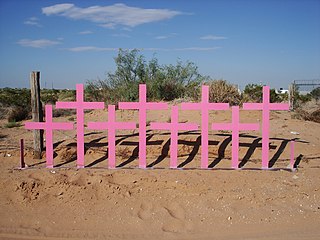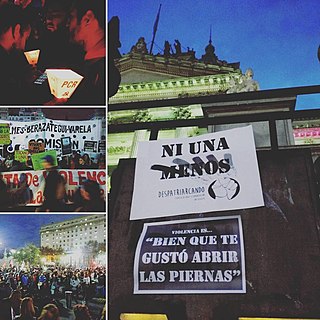
More than 500 women were killed between 1993 and 2011 in Ciudad Juárez, a city in northern Mexico. The murders of women and girls received international attention primarily due to perceived government inaction in preventing the violence and bringing perpetrators to justice. The crimes have featured in many dramas, songs, and books.

Femicide or feminicide is a term for the hate crime of systematically killing women, girls, or females in general because of their gender and/or sex. In 1976, the feminist author Diana E. H. Russell first defined the term as "the killing of females by males because they are female." Femicides are more often perpetrated by men against women. This is most likely due to unequal power between men and women as well as harmful gender roles, stereotypes, or social norms. Though femicide is not purely male-perpetrated but can be female-perpetrated as well.
Domestic violence in Brazil involves any type of violence or abuse by intimate partners or family members against one another. The majority of domestic violence cases in Brazil are performed by the man against their female partners. In 2015, the government released a study that showed that every seven minutes a woman was a victim of domestic violence in Brazil, over 70% of the Brazilian female population will suffer some kind of violence throughout their lifetime and 1 in every 4 women reports being a victim of psychological or physical violence. In 2017, Brazil had an estimate of 606 cases of violence and 164 cases of rape per day, over 60 thousand cases throughout the year. It is also estimated that only 10% of the cases are registered to the police. Although Brazil acknowledged that domestic violence was a problem in the 1940s, the Government has only acted upon it from 1980s onwards, with the creation of the Women Police Stations and later in 2006, with the publication of the Domestic Violence law.
The most pervasive violations of women's rights in Paraguay involve sexual and domestic abuse. On average one woman is murdered every 10 days. Although Paraguay has taken several measures to deal with this problem, including creating special police units for domestic violence victims, lack of adequate laws, as well as conservative attitudes within a male dominated society hinder progress.
Violence against women in Peru is defined as harassment or violence propagated against those who are born women. Intimate partner violence (IPV) is the most common form of gender-based violence that occurs though it can occur concurrently with sexual and emotional violence.
Violence against women in Mexico includes different forms of gender-based violence. It may consist of emotional, physical, sexual, and/or mental abuse. The United Nations (UN) has rated Mexico as one of the most violent countries for women in the world. According to the National Institute of Statistics and Geography in Mexico (INEGI), 66.1 percent of all women ages 15 and older have experienced some kind of violence in their lives. Forty-nine percent have suffered from emotional violence; 29 percent have suffered from emotional-patrimonial violence or discrimination; 34 percent from physical violence; and 41.3 percent of women have suffered from sexual violence. Of the women who were assaulted in some form from 2015 to 2018, 93.7 percent of them did not seek help or report their attacks to authorities.

Ni una menos is a Latin American fourth-wave grassroots feminist movement, which started in Argentina and has spread across several Latin American countries, that campaigns against gender-based violence. This mass mobilization comes as a response to various systemic issues that proliferate violence against women. In its official website, Ni una menos defines itself as a "collective scream against machista violence." The campaign was started by a collective of Argentine female artists, journalists and academics, and has grown into "a continental alliance of feminist forces". Social media was an essential factor in the propagation of the Ni Una Menos movement to other countries and regions. The movement regularly holds protests against femicides, but has also touched on topics such as gender roles, sexual harassment, gender pay gap, sexual objectification, legality of abortion, sex workers' rights and transgender rights.
Femicide in Honduras is a concept referring to murders committed against women in Honduras since 1990. According to the Penal Code in force until 2018, the crime of femicide is defined as a man or men killing a woman for reasons of gender, with hatred and contempt for her condition as a woman. Between 2002 and 2013, 3,923 women were murdered in Honduras. The number of femicides makes up 9.6% of the total number of homicides in the country. In 2013, 53 women were killed every month, and more than 90% of those cases went unpunished. More recent data reports that the level of impunity for femicides continues to be high, as it reached 95% for the 338 cases that occurred during 2017 through early 2018.

#NiUnaMenos is a Peruvian group against femicides and violence against women in the Andean country. The movement was formed in July 2016, and the march it staged in August 2016 has been characterized as the largest demonstration in Peruvian history

Cindy Arlette Contreras Bautista is a Peruvian lawyer and social activist. She is an International Women of Courage Award recipient, and was also included in the Time 100 list of the most influential people.
On 11 February 2020, Fátima Cecilia, a seven-year-old girl, disappeared, and four days later, on 15 February, was found dead in a garbage bag in a vacant lot in Tláhuac, Mexico City, Mexico with signs of physical violence and sexual abuse. The murder of Fátima has caused commotion in Mexico.

On 9 February 2020, Ingrid Escamilla Vargas, a 25-year-old woman living in Gustavo A. Madero, Mexico City, was murdered by her boyfriend, Erik Francisco Robledo Rosas in an act of femicide. Robledo was convicted and sentenced to the maximum penalty of 70 years in prison.

Isabel Agatón Santander is a Colombian poet, lawyer, writer and feminist. Promoter of the Rosa Elvira Cely Law which defines femicide as a crime in Colombia, she integrated the editorial commission of Law 1257 of 2008 about violence against women. She was a judge in the Tribunales de Conciencia de Justicia Para las Mujeres in Nicaragua (2015) and El Salvador in which they tried cases of sexual violence and femicide convened by the Red Feminista frente a la Violencia contra las Mujeres (REDFEM) and the Red contra Violencia of the respective countries.

Spain's National March in Opposition to Male Violence(s) Against Women, also known as 7N, was a mass citizen mobilisation, convened as a "feminist movement", which came to occupy the centre of Madrid on 7 November 2015. Organised by three hundred and thirty-two feminist organisations, it had the support of two hundred and twenty-two bodies, including political parties, unions and national and international feminist organisations, as well as one hundred and thirty-five district councils. The final event consisted in the reading of a manifesto compiling the condemnations and demands of the organisations involved, negotiated over nine months through working committees.
The Flora Tristán Peruvian Women's Center is a feminist non-governmental organization established in Lima in 1979 in defense of women's human rights and equality.

Femicide, broadly defined as the murder of a woman motivated by gender, is a prevalent issue in Latin America. In 2016, 14 of the top 25 nations with the highest global femicide rates were Latin American or Caribbean states. In 2021, 4,445 women were recorded victims of femicide in the region, translating to the gender-based murder of about one woman every two hours in Latin America.

An antimonumenta was installed in the Plaza de Armas, in Guadalajara, Jalisco on 25 November 2020, the date commemorating the International Day for the Elimination of Violence against Women, during the annual march of women protesting against gender violence. The sculpture is symbolically named Antimonumenta and it was inspired by the anti-monument of the same name placed in Mexico City a year prior.

An antimonumenta was installed in front of the Palace of Fine Arts, in Mexico City on 8 March 2019, the date commemorating International Women's Day, during the annual march of women protesting against gender violence.
Richard Choque Flores is a Bolivian serial killer and rapist who killed at least two women in 2021, shortly after being released from a prior conviction. For the latter crimes, he was sentenced to 30 years imprisonment.











